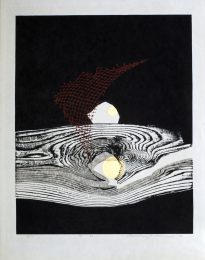

Iwami Reika was not a direct pupil of Onchi but she ranks as the last of his true ‘Sosaku Hanga’ line, having been taught by his close associates, Shinagawa Takumi (q.v.) and Sekino Jun’ichiro (q.v.). From Onchi’s example she inherited skill in cool abstraction, as well as the printing from driftwood which has become an essential part of her later work and an inter- est in embossed effects. Her neatness of technique and preference for black and white, sometimes with gold and silver foil, take her far from the cerebral, romantic and unpredictable work of the early Creative Print Movement into a perfection and occasionally a sentimentality which is more closely related to contemporary ‘Nihonga’ painting. She was born in Tokyo and first studied doll-making, as well as prints at the Sunday course of the Bunka Gakuin (Culture Institute) and subsequently at other workshops. She first exhibited in 1953 with the Japanese Print Association, from 1957 to 1964 at the Tokyo Internation- al Print Biennale, from 1957 every year at the College Women’s Association of Japan print show in Tokyo, and in 1979 at the British International Print Biennale, Bradford. All of these made her known in the West, where she became popular because of her easily understood abstractions based on water, sky, rock and driftwood forms. Her name was finally made by being included in Michener’s ‘The Modern Japanese Print. An Appreciation’ (1962) with ‘Winter Composition No. 2’. In 1957 she was one of the founders of a group of women printmakers, the Joryu Hanga Kyokai. Since 1964 she has worked only as a print- maker, producing relatively few designs in small editions, since the embossing and ‘baren’ printing in her often large compo- sitions require much physical effort, difficult for the very small woman she is.